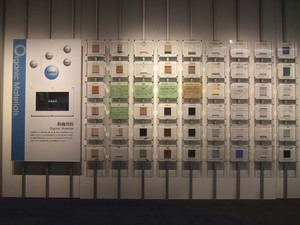Nagoya City Science Museum
TOP > Exhibition Guide > Keyword Search > Starting with "M" > material > Organic Materials
Organic Materials



Purpose of Exhibition
Materials for industrial products can be classified into three groups: ceramics, metals, and organic materials. There are indeed many organic materials, primarily plastic, rubber, paper, textile, oil, detergent, and liquid crystal. Each one of these is bonded to mainly carbon, hydrogen, and oxygen atoms.
Here are exhibited actual sample materials and video commentaries.
Additional Knowledge
We will describe typical plastics in organic materials.
[1. Raw Materials for Plastics and Synthesis]
Most plastics are made from the extract called naphtha in petroleum. The small molecules (low molecules or monomers) primarily ethylene, propylene, and benzene, which are produced when naphtha is decomposed thermally, are raw materials. A big molecule that is multiplied by polymerization and bonded with thousands or tens of thousands of the low molecules is plastic, synthetic rubber, or synthetic fiber. "Poly・・・", often seen with names of plastics, means "numerous".
Depending on the kinds of low molecules for a material and the combinations, various sorts of plastics can be produced. Moreover, even with the same type of plastics, depending on additives and the polymerization method, a product with different characteristics can be manufactured.
In plastic containers at home, the types of plastic (name of raw material used in plastic) are marked. Try checking what kinds of plastic we have and how that plastic is used.
[2.Thermoplastic Resin]
Polyethylene used in a bucket can be softened when heated and its shape can be changed in many ways. The ability to deform when force is applied and not return to the original form is called "plasticity". Originally, the word "plastic" meant "plasticity". Many plastics are "thermoplastic resins". Thermoplastic resin is a group of high molecules with a long string-like structure, like polyethylene. Because of this, when staying heated, high molecules start sliding into each other, and thermoplastic resin is softened and increases its mobility. However, if the temperature rises more than that, it is not transformed into gas. The high molecules will have been decomposed before that.
Polyethylene, polyester, polyvinyl chloride, and polystyrene are primarily the most typical examples.
[3.Thermosetting Resin]
By the way, there is a plastic that does not soften even when heated. A plastic with this property is termed as "thermosetting resin". The structure of the high molecules is not string-like, it features a three-dimensional structure like grids instead. Although the molecules cannot move, even when heated, they do not become soft.
Phenol resin, epoxy resin, and melamine resin are typical examples.
[4.Plastics and Environment]
Plastic is an inexpensive, light, and superb material. It is produced and used up in a large amount. Since plastic does not decompose by organism, used plastic waste has become a problem.
Recycling is one of the ways that we have come up with to address the issue. For example, collected pet (PET) bottles are finely crashed and reborn as primarily stationery, polyester clothes, carpets, or clear files. PET (polyethylene terephthalate) is the name of this type of plastic.
There is also a way in which a used pet bottle can be decomposed chemically into raw materials and a new one is created all over again. By not filling up the land with waste, the used bottles are burnt and the generated heat utilized as a fuel. It is also a way to recycle waste.
On the other hand, a way to produce, "biodegradable plastic" which is easy for microorganisms to decompose, is under way. There has been much focus especially on "polylactic acid". Its raw material is not petroleum, but starch extracted from plants such as corn or potatoes. It is fermented and becomes lactic acid. Moreover, when lactic acids react, they become a high molecular plastic called "Polylactic acid". It may seem that starch from plants and plastic have no relationship. But actually, these two are closely related in terms of both of them having high molecules bonded with thousands or tens of thousands of carbon atoms.
By the way, because a plant is raw material does not always mean that it is biodegradable. Additionally, there is some plastic made of petroleum which is actually biodegradable.
Article by Keiko Ishida, Curator
